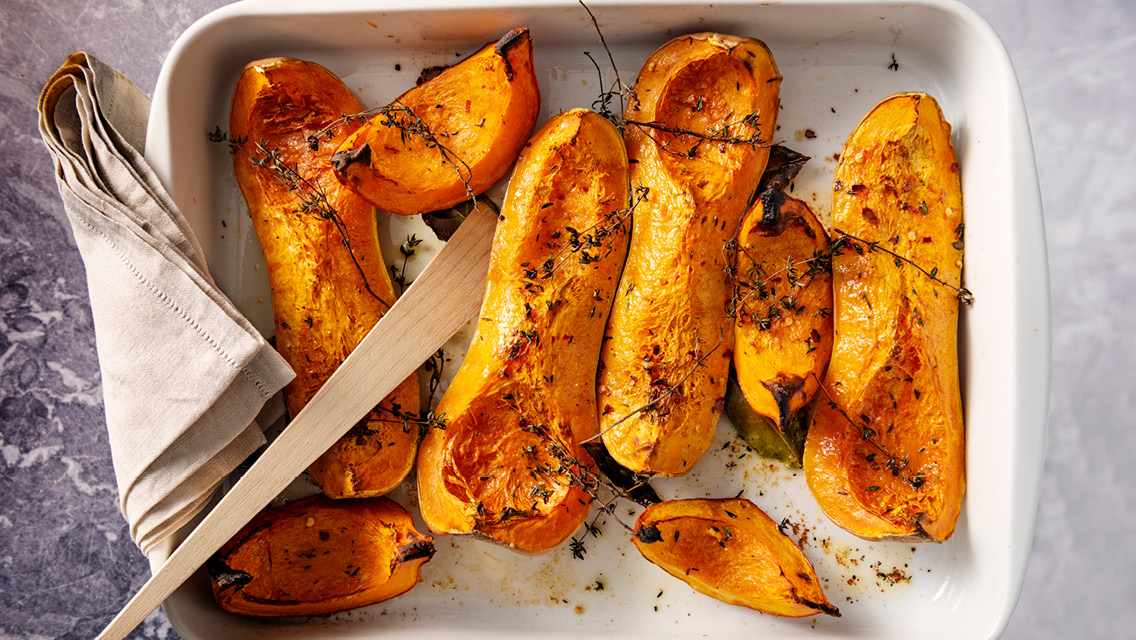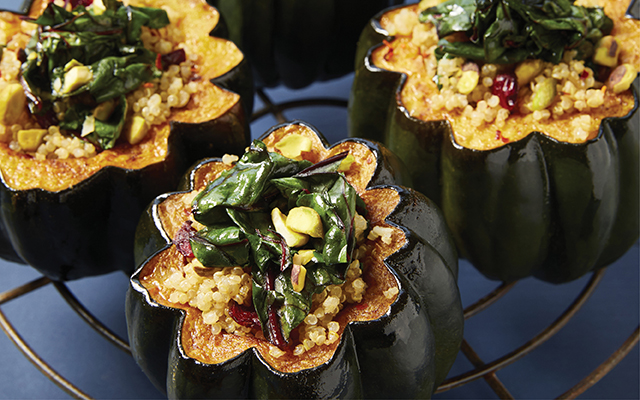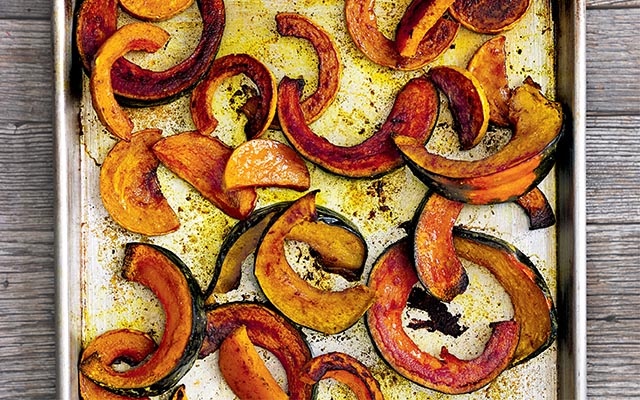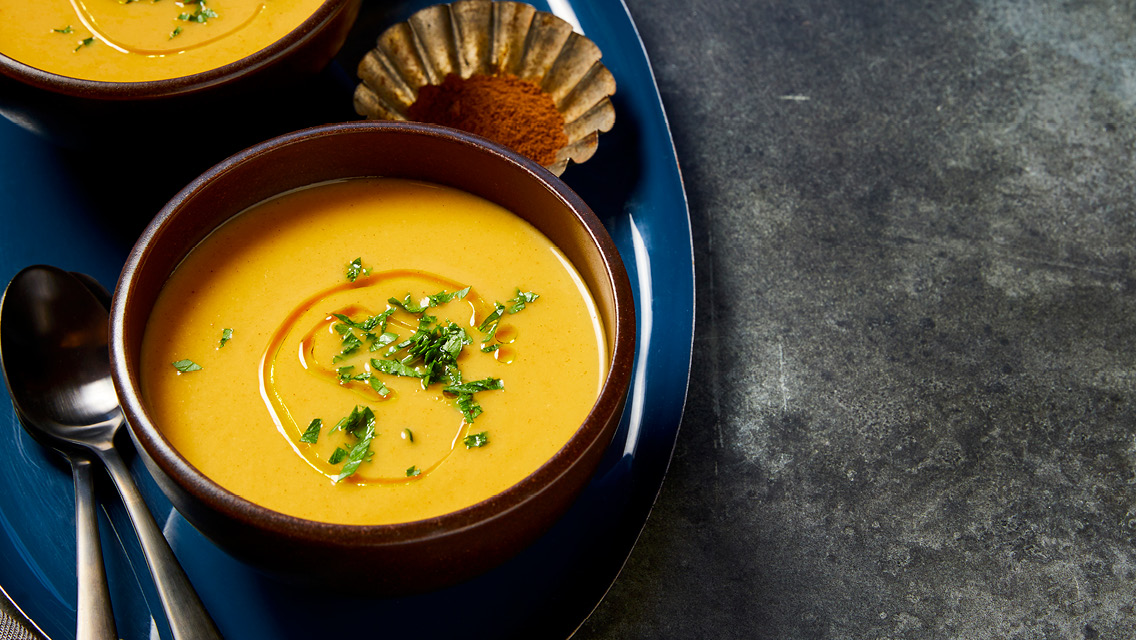We’re used to seeing colorful winter squash – pumpkin, butternut, acorn – resting on front steps and adorning kitchen tabletops. But how in the world do you eat these hard-shelled vegetables? Actually, they’re quite simple to prepare. Winter is the perfect time to fill your home with their comforting aromas – and to indulge your appetite with their rich, satisfying flavors.
Food Basics
Related to both the melon and the cucumber, winter squash come in all different shapes, sizes, flavors and varieties – from creamy and sweet delicata squash to spaghetti squash, which separates into long strands when cooked. The finely grained texture of winter squash, however, is common to all varieties. Known as “good keepers,” they have hard, protective shells that allow them to be stored for long periods (between one week and six months).
Nutritional Know-How
Winter squash are chock-full of nutritious goodness. Rich in beta-carotene and other carotenoids – which are converted to vitamin A in the liver and intestinal walls – they’re also a very good source of dietary fiber, potassium, vitamin C and manganese. Vitamin C has powerful antioxidant properties, helps minimize the risk of heart disease, and helps fight certain types of cancer cells in the body, according to recent research by the National Institutes of Health. Potassium helps the kidneys function normally and supports proper blood pressure. Fiber helps reduce the risk of colon cancer and lowers high cholesterol levels. Manganese is an essential trace mineral that helps produce certain enzymes. Winter squash also contain folate, omega-3 fatty acids, copper, and vitamins B1, B3, and B6, and they have powerful antioxidant and anti-inflammatory properties. Squash is a great source of healthy carbs.
Kitchen Basics
- Choose a squash that has a dull, deep-colored rind, is heavy for its size, and is free of moldy or soft spots.
- Store whole in a cool, dry place until ready for cooking (50 to 60 degrees F is ideal).
- To prepare winter squash for cooking, wash it first, then cut it in half lengthwise and remove the seeds with a spoon or ice cream scoop.
- Cutting through the thick skin of a winter squash can be tricky, but it can be softened by first baking it for 20 minutes. Use a heavy knife, such as a cleaver or chef’s knife. Holding the squash near the bottom (but not directly under the path of your knife) use your free hand to plunge the tip of the knife into the squash and push down to cut open as if pulling down on a lever. Repeat until you’ve cut all the way through.
Eat Up!
Winter squash can be baked, steamed, simmered, stewed, mashed and puréed. Try seasoning with honey, real maple syrup, tamari or soy, ginger, nutmeg, curry, or cinnamon. All complement winter squash well.
- For baked squash, put quarters or halves in the oven at 350 degrees F for 30 minutes or until soft. Acorn, kabocha, sweet dumpling or turban squash work best for roasting.
- To steam, place squash in steamer basket over 2 inches of boiling water; cover and cook until it can be easily pierced with a skewer or knife. Peeled cubes take about 15 minutes to steam. Halved squash, placed skin side up, takes about 30 minutes.
- Use a blender to purée cooked winter squash. Butternut, buttercup, banana and delicata squash are best for purées (and creamy soups) because of their sweet and nutty flavors.
- To add texture and flavor to a stir-fry, thinly slice raw squash and then sauté or stir-fry with other vegetables for about 2 minutes.
- Drizzle apple juice over thin rings of acorn squash before baking for a sweet, aromatic glaze.
Varieties of Winter Squash
Discover the many types of winter squash.
- Acorn: Shaped like an acorn with green skin speckled with orange patches and a pale yellow-orange flesh, this squash has a unique flavor that is a combination of sweet, nuts and pepper.
- Amber cup: Small, orange and round like a pumpkin, Amber cup squash has a dry, sweet flavor.
- Banana: Banana-like in shape and color, this variety grows up to 2-feet long and is commonly found in markets cut into small pieces.
- Buttercup: A green-skinned squash with creamy orange flesh, the buttercup is extremely sweet, making it an ideal choice for soups, purées, pies and stuffings. (It can replace sweet potatoes in most recipes.)
- Butternut: Beige-colored with a vase-like shape, butternut squash weighs 2 to 5 pounds. It has a sweet orange flesh with a sweet potato-like flavor.
- Carnival: Cream with orange spots or light green with dark green spots and vertical lines, the carnival’s sweet yellow meat can be baked or steamed.
- Delicata: This squash is also known as sweet potato squash because of its creamy, sweet potato-like flavor. It has a thin edible skin and a relatively short shelf life compared to other winter squashes.
- Gold Nugget: With its orange skin and flesh and small pumpkin shape, the Gold Nugget is often referred to as an Oriental pumpkin. It can be cooked whole or halved.
- Hubbard squash: A larger-sized squash that can be dark green, gray-blue or orange-red in color, the Hubbard has irregular shapes and extra hard skin. The Hubbard’s flavor is less sweet than many other varieties.
- Kabocha: Also known as Hokkaido or Japanese pumpkin, Kabocha has sweet flavors and can be dry and flaky when cooked.
- Spaghetti: A golden yellow watermelon-shaped variety that can range from 2 to 5 pounds, spaghetti squash has a mild nutty flavor. Its flesh separates into spaghetti-like strands when cooked.
- Sweet dumpling: A small, pumpkin-shaped squash that only weighs about 7 ounces, the sweet dumpling has a mildly sweet flavor and is ideal for roasting whole and stuffing.
- Turban squash: Green, orange or white in color, and either speckled or striped, this winter squash has a yellow flesh that tastes a bit like hazelnuts.
Butternut Squash and Roast Chestnut Souffle in an Onion Cup
Makes eight servings
For the Onion Cup
- 2 large yellow onions
- 2 quarts water
- 1 tsp. sea salt
- Ice
Onion Cup Directions
- Heat water with salt in a large saucepot.
- Remove the skin from the onion and discard. Cut off 1/4 inch from the root and 3/4 inch from the top of the onion. Place the onion in the boiling, salted water for 45 seconds to one minute. Boil just long enough for the outer later of the onion to be cooked.
- Place the onion in an ice bath for 30 seconds to stop the cooking process. Remove the onion from the ice bath, and press the center of the onion up while squeezing the outer skin.
- Repeat this process until you have eight onion cups.
For the Chestnuts
- 1/2 cup chestnuts
Chestnut Directions
- Preheat the oven to 450 degrees F.
- Cut a small incision in each chestnut. Place the chestnuts on a baking pan and roast for 15 to 20 minutes. The shells will burst open.
- Remove from the oven, peel the shell away from the nut.
For the Butternut Squash
- 1 large (3 1/2 cups) butternut squash
Squash Directions
- Preheat the oven to 375 degrees F.
- Cut the butternut squash in half. Scoop out the seeds, then prick it with the tines of a fork.
- Place the squash on a baking pan and bake for 20 to 25 minutes, or until it is soft.
- Spoon the squash out of its outer skin.
For the Soufflé
- 3 1/2 cups cooked butternut squash
- 1/2 cup roasted chestnuts
- 1/4 tsp. freshly grated nutmet
- 1/2 tsp. sea salt
- 1/8 tsp. white pepper
- 10 egg whites, whipped to stiff peaks
- 8 onion cups
Soufflé Directions
- Preheat the oven to 350 degrees F.
- Place the butternut squash in a food processor and purée with the roasted chestnuts until smooth.
- Season the squash mixture with salt, pepper and nutmeg. Remove the mixture from the food processor and place in a medium bowl.
- Whip the egg whites to medium stiff peaks, and fold them into the squash mixture. Spoon the mixture into the onion cups, and place them on a baking pan.
- Bake for 15 minutes. Serve with braised fresh vegetables.
Calories 141; Fat: 1 g
Pumpkin Flan
Makes eight servings
- 3 cups pumpkin purée (canned or fresh cooked)
- 1 whole egg
- 3 egg whites
- 1 cup evaporated skim milk
- 1/2 tsp. sea salt
- 1/4 tsp. white pepper
- 1/2 tsp. ground cinnamon
- 1/2 tsp. ground all-spice
- 1/2 tsp. ground ginger
- 1/2 tsp. ground cloves
- 1/2 tsp. ground nutmeg
Directions
- Preheat the oven to 325 degrees F (165 degrees C).
- Lightly coat eight ramekins or oven-safe coffee cups with cooking spray. Pour 1 inch of water into a 13×9-inch baking pan to use as a water bath.
- Place all the ingredients in a blender and purée for two to three minutes, or until smooth and incorporated. Spoon 1/2 cup of the pumpkin mixture into the prepared cups. Place the filled cups into the water bath. Bake for 25 to 30 minutes or until firm to the touch. Keep warm in the water bath until ready to serve.
- The flan can be served in the ramekins, or you can carefully run a knife around the edge of the cup and turn it upside down on a serving plate to unmold.
Per serving: 4 ounces Calories 60; Protein 5 g; Total Fat 1 g; Saturated Fat 0 g; Carbohydrates 9 g; Dietary Fiber 1 g; Cholesterol 30 mg; Sodium 210 mg
Butternut Squash Soup
Makes 5 servings
- 1/4 tsp. extra-virgin olive oil
- 4 to 5 cups diced, peeled butternut squash
- 1 cup chopped yellow onion (about one large)
- 1 cup chopped celery (three medium ribs)
- 1 bay leaf
- 4 cups vegetable stock
- 2 tbs. minced fresh oregano
- 1/4 tsp. ground nutmeg
- 1/2 tsp. sea salt
- 1/4 tsp. freshly ground black pepper
Directions
- Heat a medium stockpot over medium-high heat. Add the olive oil to lightly coat the bottom of the pan.
- Add the squash, onion and celery. Cook until the onion has softened, about two minutes.
- Add the bay leaf and cook for two minutes.
- Add enough of the stock to cover the vegetables, and bring to a boil. Reduce heat and simmer until the squash is very soft, 20 to 25 minutes.
- Stir in the oregano, nutmeg, salt and pepper. Remove the bay leaf.
- Carefully ladle the soup into a blender and process until pureed and smooth. Strain through a fine mesh strainer or a colander lined with cheese cloth to remove any squash pulp.
- Return the strained soup to a pan over low heat. Taste and adjust the seasoning with additional salt, pepper and nutmeg, if desired. Add a little more stock or water to give the soup a creamy consistency if it seems too think.
Per serving (1 cup): Calories 120; Protein 3 g; Total Fat 1 g; Saturated Fat 0 g; Carbohydrates 30 g; Dietary Fiber 8 g; Cholesterol 0 mg; Sodium 290 mg
Recipes presented by Conscious Cuisine®
This article has been updated. It originally appeared online on December 1, 2006.




This Post Has 0 Comments